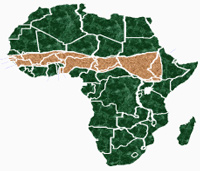Impact of the problem
Geographic distribution
Meningococcal disease was described as far back as 1805 when an outbreak swept Geneva, Switzerland. However, the causative agent of meningococcal meningitis was identified only in 1887. Major outbreaks were subsequently noted during the two world wars and epidemics have been reported on the African continent since 1909.
Asia has had some major epidemics of meningococcal disease in the last 30 years (China 1979 and 1980, Viet Nam 1977, Mongolia 1973-1974 and 1994-1995, Saudi Arabia 1987, Yemen 1988). There have also been epidemics in Europe and in the Americas during the last 30 years, but they have not reached the very high incidence levels of epidemics in other parts of the world. The largest and most frequently recurring outbreaks have been in the semi-arid area of sub-Saharan Africa.

This area, known as the African meningitis belt stretches from Senegal to Ethiopia, with an estimated total population of approximately 300 million. Epidemics occur in seasonal cycles between the end of November and the end of June, depending on the location and climate of the country, and decline rapidly with the arrival of the rainy season. Within the meningitis belt, meningococcal disease occurs in epidemic cycles which last between 8 to 15 years.
The most recent meningococcal meningitis pandemic began in the mid-1990s. In 1996, almost 190 000 cases were notified to WHO in Burkina Faso, Chad, Mali, Niger, Nigeria and other countries. The response to the epidemic by these countries paralyzed the routine health care systems and exhausted international stocks of vaccine. In 1997, the International Coordinating Group (ICG) for Vaccine Provision for Epidemic Meningitis Control was established.
Countries have reported numbers of cases and deaths of meningococcal disease to WHO in: 1998; 1999; 2000
In 2001, 6 countries in the African meningitis belt experienced large epidemics: Benin, Burkina Faso, Central African Republic, Chad, Ethiopia, Niger. A brief descriptive overview of the affected areas is found in Epidemics of meningococcal disease, African meningitis belt, 2001.
In 2002, the following countries have reported these numbers of cases and deaths to WHO.

-
Enhancing meningitis surveillance in Africa in 2003
After the outbreak of Neisseria meningitidis W135 that affected Burkina Faso in 2002, there was an increasing risk of further epidemics linked to W135 in 2003. These risks brought new challenges: the need for timely detection of the involvement of W135 and the recent availability of low cost trivalent (A/C/W) vaccine.
Socioeconomic impact
The socioeconomic implications of epidemic meningococcal disease are serious. Control and prevention of the epidemic require a considerable amount of vaccine, medicines and logistical support from the national health authorities of the affected countries. Most countries face great difficulty in responding appropriately to these needs. In addition, routine health services and other important activities are disrupted.
Factors linked to a higher incidence of meningococcal disease include poor living conditions and overcrowded housing, and the impact of the disease is greatest among underprivileged populations. Travel and migration also facilitate the circulation of pathogenic strains inside a country or from country to country and large population movements such as pilgrimages may play a major role in the spread of infection. Other large population displacements, e.g. those of refugees, may pose similar risks. Waning herd immunity to a particular strain in a population may be necessary for an outbreak to occur and could contribute to the regularity of epidemic cycles in sub-Saharan Africa.





